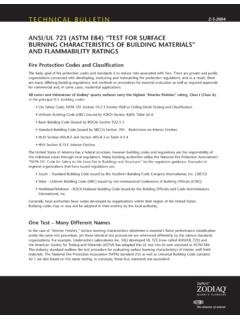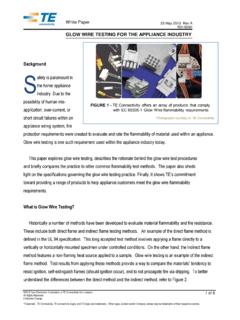Transcription of European Fire Standards
1 Flammability testing is arguably one of the most important testing procedures within the textile industry because it has crucial safety implications in the event of a fire. It has been statistically shown that the major cause of fatalities in fire can be directly attributed to the accidental ignition of upholstery and textiles, so it is only sensible that proper flammability Standards should be in place. Flammability performance can be improved by the fabric manufacturer at the design stage to ensure a safer interior environment. Unfortunately, there is no single flammability standard for upholstery or vertical surface fabrics which has been adopted as the norm throughout the world and the plethora of different Standards in force internationally reflects the different ways of approaching the whole flammability issue. A single standard has been brought in which is acceptable throughout the European Union, EN 1021 : 1994, but this only covers cigarette and match tests - nothing more rigorous - and other national tests continue to proliferate.
2 This guide looks at some of the most important international Standards and test methods which apply to upholstery fabrics. Sadly, it can never be a definitive document, but should hopefully provide a better insight into the main regional variations and the complex issue that flammability testing has become. European Standards EN 1021 - 1/2 : 1994 This standard is valid throughout the EU and examines a fabric's reaction to a burning cigarette and butane flame (simulated match). It replaces a number of national tests , including DIN 54342 : 1/2 in Germany and BS 5852 : 1990 in the UK. Test Methods A standard test rig is constructed from fabric and foam to form a simulated chair with the back at a right angle to the base. This enables the ignition source to be kept in permanent contact with both back and seat throughout the test.
3 Watersoak prior to testing is compulsary. EN 1021 : Part 1 In Part 1 of the test a lighted cigarette is placed in the angle of the test rig and left to smoulder along its entire length. After 60 minutes no smouldering or flaming of the fabric should be observed. EN 1021 : Part 2 Here a butane flame 35mm in height is used to represent a burning match and is applied for 15 seconds, again in the angle between the test rig base and back. After the flame is removed, no burning of the fabric should occur after 2 minutes have elapsed. Germany In Germany, upholstery fabrics are tested in accordance with DIN 4102 which has been established by the Deutsches Institut f r Bautechnik. DIN 4102 Part 1 - Kleinbrenner (B2) All materials used in buildings in Germany need to meet the B2 requirement which is determined using a small flame test. The fabric specimen is suspended vertically and a 20mm high flame is applied for 15 seconds to both the fabric surface and edge.
4 Reference lines are marked on the specimen, which achieves B2 classification if the tip of the flame does not reach the reference marks within 20 seconds on any sample. 5 samples are tested with filter paper being placed below each to determine the production of flaming droplets. DIN 4102 Parts 15/16 - Brandschacht (B1) Referred to as the "Brandschacht test", this is the main test method in Germany which measures reaction to fire and is considered the highest flammability standard in the country for upholstery fabrics. The term Brandschacht, literally "fire shaft", refers to the testing apparatus itself which consists of a square-shaped vertical housing equipped with a gas burner. Four fabric samples are held vertically in a supporting frame and subjected to flames for 10 minutes. At the same time a constant, uniform flow of air is blown into the Brandschacht from below.
5 In evaluating the test, smoke gas temperature and the mean residual length of the sample are taken into account (residual length is the part of the specimen which has escaped burning). In order to be classified as B1, the tested fabric must show: 1. A mean residual length of not less than 150mm, with no specimen being burned away completely 2. A mean smoke gas temperature of less than 200oC France NFP 92 - 503 - Br leur lectrique The French test known as the "Br leur lectrique" - electric burner - is the principal method used not only in France, but also in Belgium, Spain and Portugal. It results in a classification of M1 to M4, with M1 being the highest classification. The sample is placed face down on the test rig at an angle of 30o above an electric radiator which gives out heat. A small butane gas pilot flame is applied directly to the fabric surface at 20 seconds into the test, held in position for 5 seconds then withdrawn.
6 The flame is applied again at 45 seconds and subsequently every 30 seconds for the duration of the 5 minute test. If any flaming continues after 5 minutes, the test is continued until the specimen extinguishes completely. The following aspects are noted during the test:- - duration of flaming - production of burning droplets - length/width of the damaged specimen Actual classification requirements are given below:- Classification M1 M2 M3 >M3 Duration of Combustion s <=5 >5 >5 >5 Length mm - <350 <600 600 Damaged Width mm - - <90 >90 Droplets none none none NFP 92-504 - Rate of flame spread test This complimentary test to the Electric Burner helps establish a classification on samples which behave unusually during the primary test - for example, melting rapidly or shrinking away to form a hole so that the pilot flame cannot come into contact with the sample at 20 seconds, or if samples were unable to achieve an M3 rating.
7 For materials which melt or shrink away from the heat source, after flame, non-propagation of flame and burning/non burning droplets are observed. Rate of flame spread is also measured if the material does not achieve M3. The non-propagation of flame test involves a flame being held against the free end of a horizontal sample, 10 times for 5 seconds; the time of after flame is measured. In the flame spread test, the time taken for flame to spread between two reference marks at 50mm and 300mm is established. The production of burning droplets is also noted. Classification criteria are given below:- Classification M1 M2 M3 a M3 b M4 Duration of Combustion none <5s <5s >5s >5s Droplets None or non burning None or non burning Burning None or non burning Burning NFP 92-505 - Dripping test Again complimentary to the electric burner, the dripping test is employed to investigate further into the potential hazard of burning droplets observed during the primary test.
8 A sample is placed on a grid 30mm below a radiator and a receptacle containing cotton wool is positioned 300mm below the grid. Heat is applied from the radiator for 10 minutes and the test is repeated 4 times. If the cotton wool sets alight, the fabric is classified M4. If it does not ignite, even if flaming or molten drips are produced from the sample, the original classification from the electric burner test is retained. United Kingdom BS 5852 : 1990 This defines the actual test method whereby a specially constructed test rig is designed to form a simulated chair, as described in EN 1021. The foam used is not specified. Of the eight ignition sources, the most frequently used are Ignition Source 0 (cigarette), Ignition Source 1 (butane flame/simulated match) and Ignition Source 5 (Crib 5). Moving up the ignition source scale, the heat intensity roughly doubles as compared to that of its predecessor.
9 The requirements for the cigarette and match tests are the same as those detailed under EN 1021, although the match application time was previously 20 seconds before the European Norm was introduced. The Ignition Source 5 test is more rigorous due to the increased intensity of heat which is generated from the wooden crib structure. Alcohol is added to the small piece of lint at the bottom of the crib which is then placed on the test rig and ignited within 2 minutes. For a pass to be recorded, all flaming should cease within 10 minutes. BS 7176 : 1995 BS 7176 is a performance standard based on BS 5852, but with three additional parameters:- (i) Watersoak procedure (ii) Predictive "Worst Case" testing (iii) Hazard categories Watersoak This procedure is defined precisely in BS 5651 : 1990 Clause 3, but in simple terms requires that a fabric be soaked in water and dried prior to testing.
10 This is done because chemically treated material may be adversely affected by watersoaking and its additional flame retardant characteristics may be greatly reduced or completely eliminated. Predictive worst case testing Here the foam used on the test rig is 35kg/m3 High Resilient (HR) foam (not CMHR foam). This has been adopted as a 'worst case' foam on the assumption that the vast majority of manufacturers use Combustion Modified foam which gives better flammability performance. Hazard Categories BS 7176 also helps to identify varying 'hazard' categories which are linked directly to the ignition source used for testing. There are four categories:- Low Hazard Medium Hazard High Hazard Very High Hazard Typical Examples of usage Offices, Colleges, Museums, Exhibitions, Hotel Bedrooms Public Buildings Restaurants Services Messes Sleeping accomodation in certain hospital wards and in certain hostels.



